Critical Review: Qualitative Studies on Catheter-Associated Infections
VerifiedAdded on 2022/09/17
|6
|1685
|25
Report
AI Summary
This report critically analyzes two qualitative studies focused on the prevention of catheter-associated urinary tract infections (CAUTI). The first study examines the efficacy of an electronic reminder system (CATH TAG) in reducing urinary catheter use among hospitalized patients, employing a mixed-methods approach. The study aims to determine if the device affects nurses' ability to provide patient care. The second study investigates long-term CAUTI prevention through an educational program and daily checklist for indwelling catheter maintenance in critically ill patients, utilizing a quasi-experimental design. Both studies highlight the significant health risks associated with CAUTI and explore strategies to minimize infection rates, emphasizing the importance of staff education, continuous monitoring, and appropriate catheter management within nursing practice. The report discusses ethical aspects, methodologies, results, and the implications of these studies for improving patient outcomes in healthcare settings.
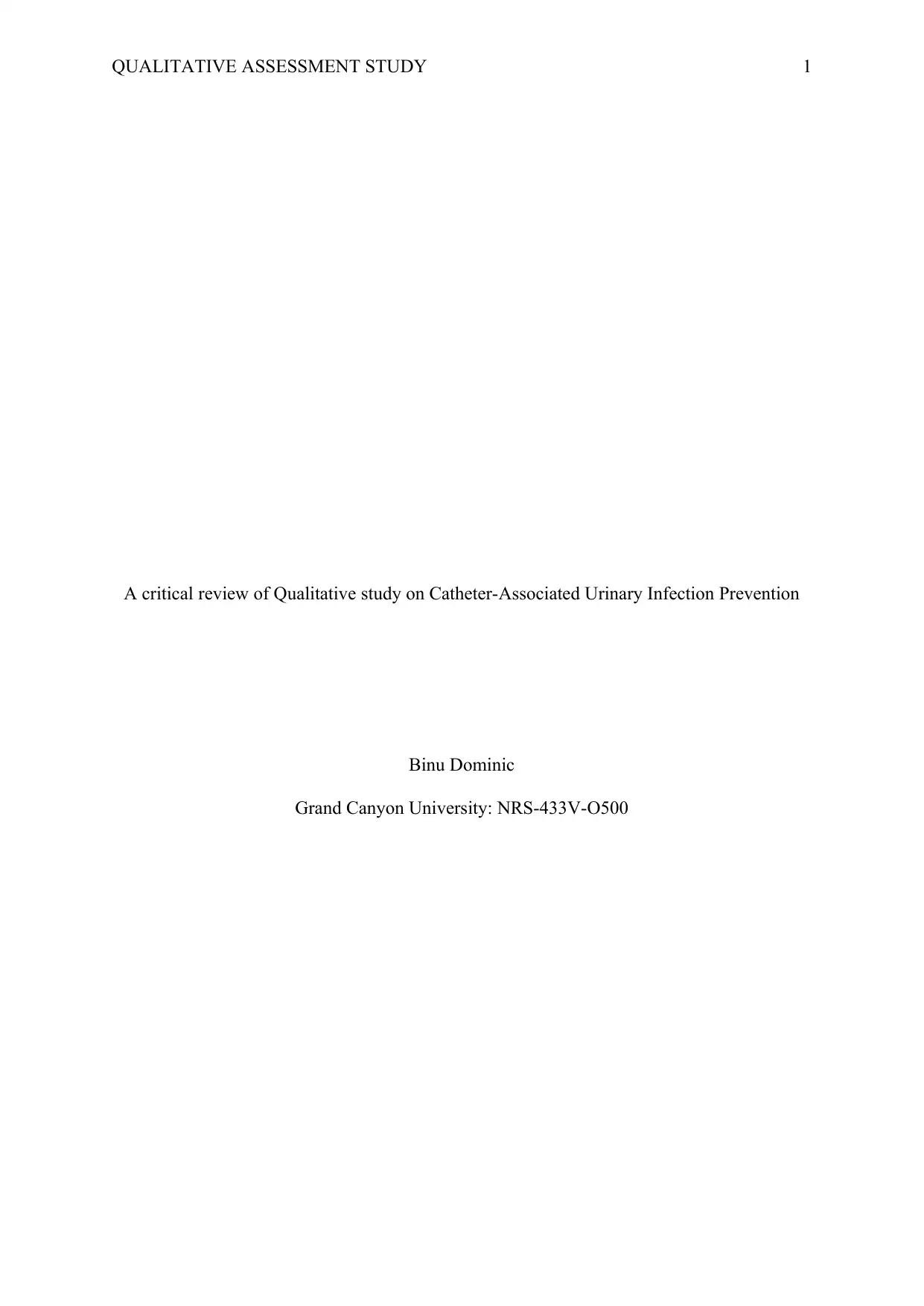
QUALITATIVE ASSESSMENT STUDY 1
A critical review of Qualitative study on Catheter-Associated Urinary Infection Prevention
Binu Dominic
Grand Canyon University: NRS-433V-O500
A critical review of Qualitative study on Catheter-Associated Urinary Infection Prevention
Binu Dominic
Grand Canyon University: NRS-433V-O500
Paraphrase This Document
Need a fresh take? Get an instant paraphrase of this document with our AI Paraphraser
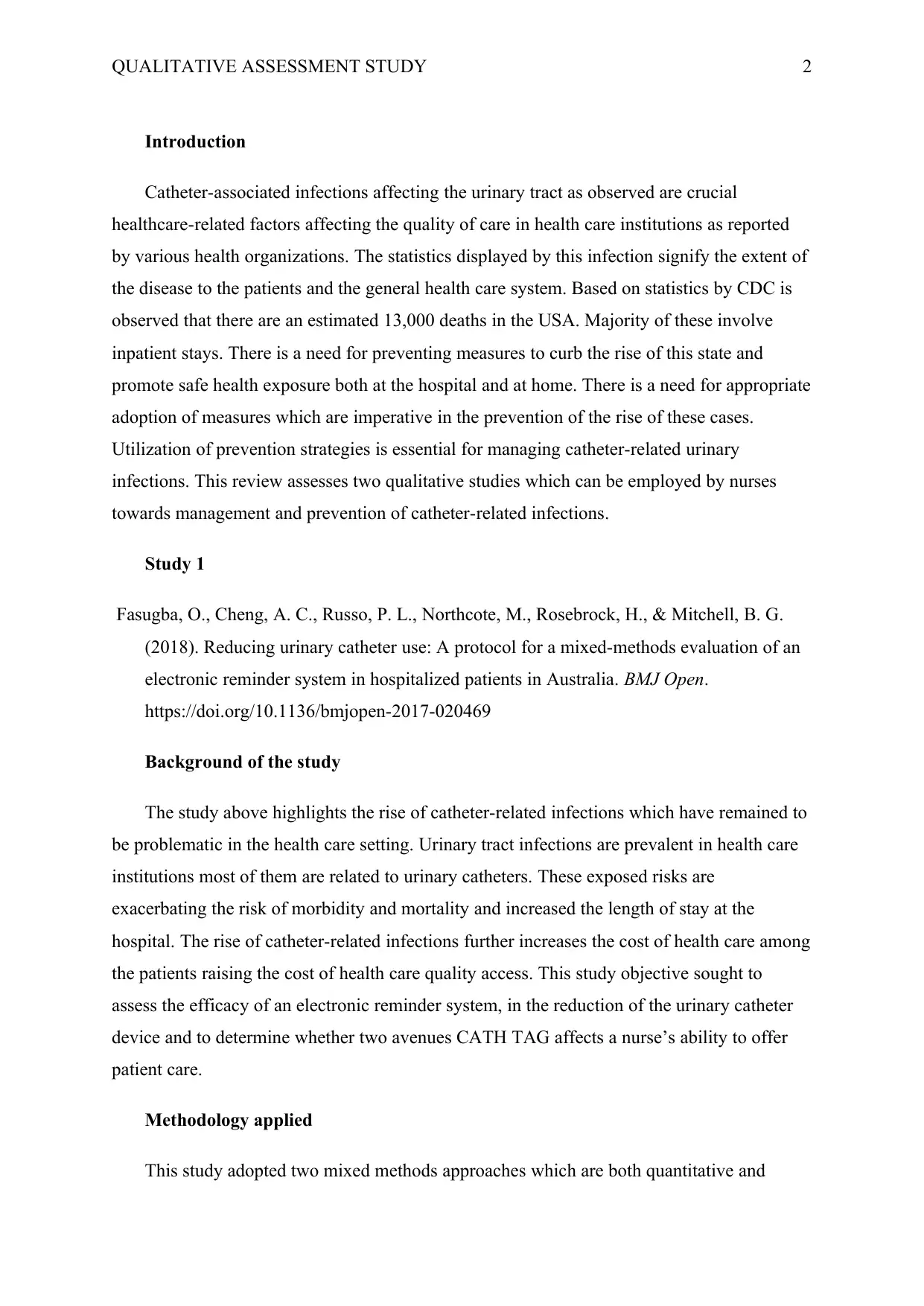
QUALITATIVE ASSESSMENT STUDY 2
Introduction
Catheter-associated infections affecting the urinary tract as observed are crucial
healthcare-related factors affecting the quality of care in health care institutions as reported
by various health organizations. The statistics displayed by this infection signify the extent of
the disease to the patients and the general health care system. Based on statistics by CDC is
observed that there are an estimated 13,000 deaths in the USA. Majority of these involve
inpatient stays. There is a need for preventing measures to curb the rise of this state and
promote safe health exposure both at the hospital and at home. There is a need for appropriate
adoption of measures which are imperative in the prevention of the rise of these cases.
Utilization of prevention strategies is essential for managing catheter-related urinary
infections. This review assesses two qualitative studies which can be employed by nurses
towards management and prevention of catheter-related infections.
Study 1
Fasugba, O., Cheng, A. C., Russo, P. L., Northcote, M., Rosebrock, H., & Mitchell, B. G.
(2018). Reducing urinary catheter use: A protocol for a mixed-methods evaluation of an
electronic reminder system in hospitalized patients in Australia. BMJ Open.
https://doi.org/10.1136/bmjopen-2017-020469
Background of the study
The study above highlights the rise of catheter-related infections which have remained to
be problematic in the health care setting. Urinary tract infections are prevalent in health care
institutions most of them are related to urinary catheters. These exposed risks are
exacerbating the risk of morbidity and mortality and increased the length of stay at the
hospital. The rise of catheter-related infections further increases the cost of health care among
the patients raising the cost of health care quality access. This study objective sought to
assess the efficacy of an electronic reminder system, in the reduction of the urinary catheter
device and to determine whether two avenues CATH TAG affects a nurse’s ability to offer
patient care.
Methodology applied
This study adopted two mixed methods approaches which are both quantitative and
Introduction
Catheter-associated infections affecting the urinary tract as observed are crucial
healthcare-related factors affecting the quality of care in health care institutions as reported
by various health organizations. The statistics displayed by this infection signify the extent of
the disease to the patients and the general health care system. Based on statistics by CDC is
observed that there are an estimated 13,000 deaths in the USA. Majority of these involve
inpatient stays. There is a need for preventing measures to curb the rise of this state and
promote safe health exposure both at the hospital and at home. There is a need for appropriate
adoption of measures which are imperative in the prevention of the rise of these cases.
Utilization of prevention strategies is essential for managing catheter-related urinary
infections. This review assesses two qualitative studies which can be employed by nurses
towards management and prevention of catheter-related infections.
Study 1
Fasugba, O., Cheng, A. C., Russo, P. L., Northcote, M., Rosebrock, H., & Mitchell, B. G.
(2018). Reducing urinary catheter use: A protocol for a mixed-methods evaluation of an
electronic reminder system in hospitalized patients in Australia. BMJ Open.
https://doi.org/10.1136/bmjopen-2017-020469
Background of the study
The study above highlights the rise of catheter-related infections which have remained to
be problematic in the health care setting. Urinary tract infections are prevalent in health care
institutions most of them are related to urinary catheters. These exposed risks are
exacerbating the risk of morbidity and mortality and increased the length of stay at the
hospital. The rise of catheter-related infections further increases the cost of health care among
the patients raising the cost of health care quality access. This study objective sought to
assess the efficacy of an electronic reminder system, in the reduction of the urinary catheter
device and to determine whether two avenues CATH TAG affects a nurse’s ability to offer
patient care.
Methodology applied
This study adopted two mixed methods approaches which are both quantitative and
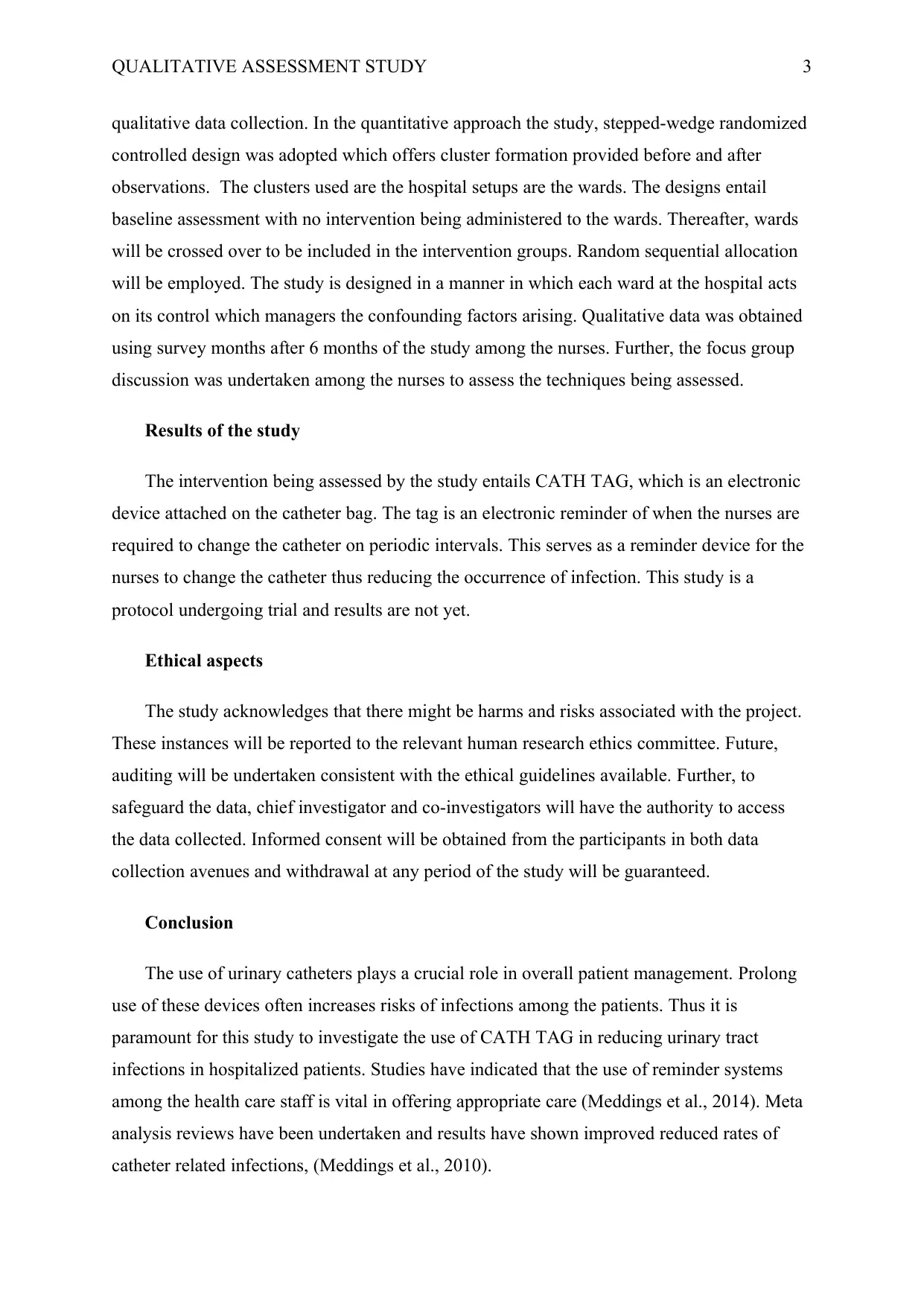
QUALITATIVE ASSESSMENT STUDY 3
qualitative data collection. In the quantitative approach the study, stepped-wedge randomized
controlled design was adopted which offers cluster formation provided before and after
observations. The clusters used are the hospital setups are the wards. The designs entail
baseline assessment with no intervention being administered to the wards. Thereafter, wards
will be crossed over to be included in the intervention groups. Random sequential allocation
will be employed. The study is designed in a manner in which each ward at the hospital acts
on its control which managers the confounding factors arising. Qualitative data was obtained
using survey months after 6 months of the study among the nurses. Further, the focus group
discussion was undertaken among the nurses to assess the techniques being assessed.
Results of the study
The intervention being assessed by the study entails CATH TAG, which is an electronic
device attached on the catheter bag. The tag is an electronic reminder of when the nurses are
required to change the catheter on periodic intervals. This serves as a reminder device for the
nurses to change the catheter thus reducing the occurrence of infection. This study is a
protocol undergoing trial and results are not yet.
Ethical aspects
The study acknowledges that there might be harms and risks associated with the project.
These instances will be reported to the relevant human research ethics committee. Future,
auditing will be undertaken consistent with the ethical guidelines available. Further, to
safeguard the data, chief investigator and co-investigators will have the authority to access
the data collected. Informed consent will be obtained from the participants in both data
collection avenues and withdrawal at any period of the study will be guaranteed.
Conclusion
The use of urinary catheters plays a crucial role in overall patient management. Prolong
use of these devices often increases risks of infections among the patients. Thus it is
paramount for this study to investigate the use of CATH TAG in reducing urinary tract
infections in hospitalized patients. Studies have indicated that the use of reminder systems
among the health care staff is vital in offering appropriate care (Meddings et al., 2014). Meta
analysis reviews have been undertaken and results have shown improved reduced rates of
catheter related infections, (Meddings et al., 2010).
qualitative data collection. In the quantitative approach the study, stepped-wedge randomized
controlled design was adopted which offers cluster formation provided before and after
observations. The clusters used are the hospital setups are the wards. The designs entail
baseline assessment with no intervention being administered to the wards. Thereafter, wards
will be crossed over to be included in the intervention groups. Random sequential allocation
will be employed. The study is designed in a manner in which each ward at the hospital acts
on its control which managers the confounding factors arising. Qualitative data was obtained
using survey months after 6 months of the study among the nurses. Further, the focus group
discussion was undertaken among the nurses to assess the techniques being assessed.
Results of the study
The intervention being assessed by the study entails CATH TAG, which is an electronic
device attached on the catheter bag. The tag is an electronic reminder of when the nurses are
required to change the catheter on periodic intervals. This serves as a reminder device for the
nurses to change the catheter thus reducing the occurrence of infection. This study is a
protocol undergoing trial and results are not yet.
Ethical aspects
The study acknowledges that there might be harms and risks associated with the project.
These instances will be reported to the relevant human research ethics committee. Future,
auditing will be undertaken consistent with the ethical guidelines available. Further, to
safeguard the data, chief investigator and co-investigators will have the authority to access
the data collected. Informed consent will be obtained from the participants in both data
collection avenues and withdrawal at any period of the study will be guaranteed.
Conclusion
The use of urinary catheters plays a crucial role in overall patient management. Prolong
use of these devices often increases risks of infections among the patients. Thus it is
paramount for this study to investigate the use of CATH TAG in reducing urinary tract
infections in hospitalized patients. Studies have indicated that the use of reminder systems
among the health care staff is vital in offering appropriate care (Meddings et al., 2014). Meta
analysis reviews have been undertaken and results have shown improved reduced rates of
catheter related infections, (Meddings et al., 2010).
⊘ This is a preview!⊘
Do you want full access?
Subscribe today to unlock all pages.

Trusted by 1+ million students worldwide
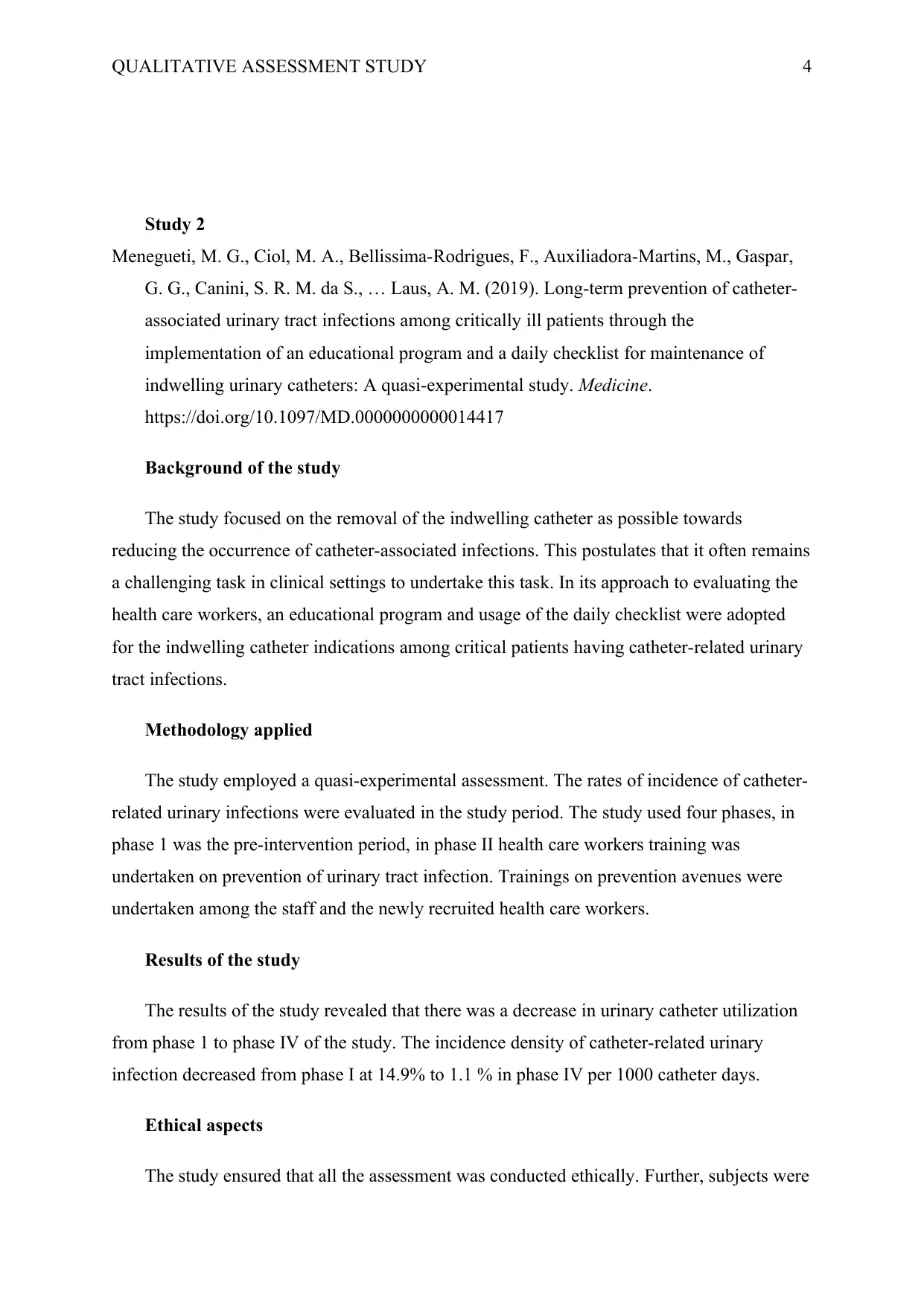
QUALITATIVE ASSESSMENT STUDY 4
Study 2
Menegueti, M. G., Ciol, M. A., Bellissima-Rodrigues, F., Auxiliadora-Martins, M., Gaspar,
G. G., Canini, S. R. M. da S., … Laus, A. M. (2019). Long-term prevention of catheter-
associated urinary tract infections among critically ill patients through the
implementation of an educational program and a daily checklist for maintenance of
indwelling urinary catheters: A quasi-experimental study. Medicine.
https://doi.org/10.1097/MD.0000000000014417
Background of the study
The study focused on the removal of the indwelling catheter as possible towards
reducing the occurrence of catheter-associated infections. This postulates that it often remains
a challenging task in clinical settings to undertake this task. In its approach to evaluating the
health care workers, an educational program and usage of the daily checklist were adopted
for the indwelling catheter indications among critical patients having catheter-related urinary
tract infections.
Methodology applied
The study employed a quasi-experimental assessment. The rates of incidence of catheter-
related urinary infections were evaluated in the study period. The study used four phases, in
phase 1 was the pre-intervention period, in phase II health care workers training was
undertaken on prevention of urinary tract infection. Trainings on prevention avenues were
undertaken among the staff and the newly recruited health care workers.
Results of the study
The results of the study revealed that there was a decrease in urinary catheter utilization
from phase 1 to phase IV of the study. The incidence density of catheter-related urinary
infection decreased from phase I at 14.9% to 1.1 % in phase IV per 1000 catheter days.
Ethical aspects
The study ensured that all the assessment was conducted ethically. Further, subjects were
Study 2
Menegueti, M. G., Ciol, M. A., Bellissima-Rodrigues, F., Auxiliadora-Martins, M., Gaspar,
G. G., Canini, S. R. M. da S., … Laus, A. M. (2019). Long-term prevention of catheter-
associated urinary tract infections among critically ill patients through the
implementation of an educational program and a daily checklist for maintenance of
indwelling urinary catheters: A quasi-experimental study. Medicine.
https://doi.org/10.1097/MD.0000000000014417
Background of the study
The study focused on the removal of the indwelling catheter as possible towards
reducing the occurrence of catheter-associated infections. This postulates that it often remains
a challenging task in clinical settings to undertake this task. In its approach to evaluating the
health care workers, an educational program and usage of the daily checklist were adopted
for the indwelling catheter indications among critical patients having catheter-related urinary
tract infections.
Methodology applied
The study employed a quasi-experimental assessment. The rates of incidence of catheter-
related urinary infections were evaluated in the study period. The study used four phases, in
phase 1 was the pre-intervention period, in phase II health care workers training was
undertaken on prevention of urinary tract infection. Trainings on prevention avenues were
undertaken among the staff and the newly recruited health care workers.
Results of the study
The results of the study revealed that there was a decrease in urinary catheter utilization
from phase 1 to phase IV of the study. The incidence density of catheter-related urinary
infection decreased from phase I at 14.9% to 1.1 % in phase IV per 1000 catheter days.
Ethical aspects
The study ensured that all the assessment was conducted ethically. Further, subjects were
Paraphrase This Document
Need a fresh take? Get an instant paraphrase of this document with our AI Paraphraser
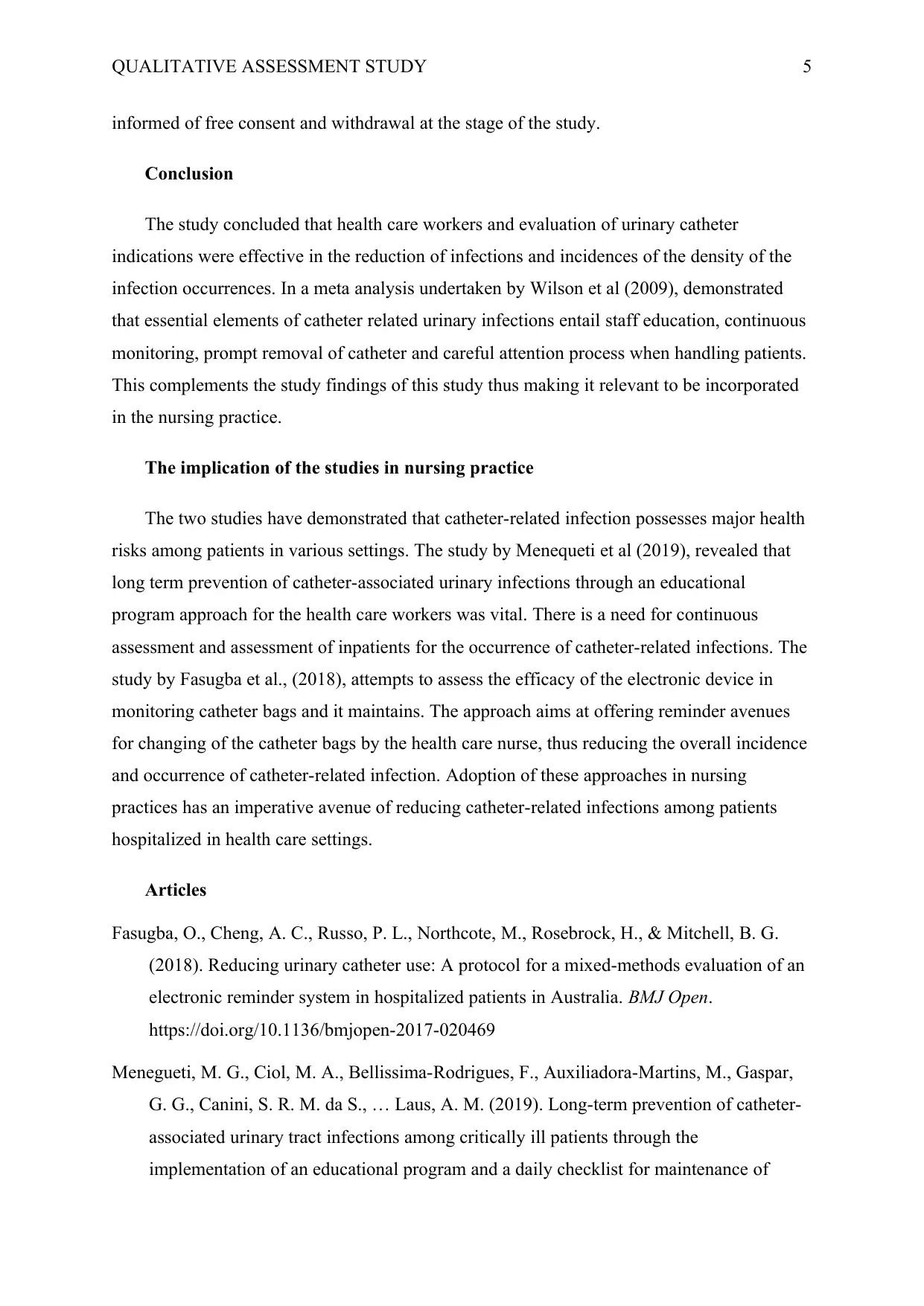
QUALITATIVE ASSESSMENT STUDY 5
informed of free consent and withdrawal at the stage of the study.
Conclusion
The study concluded that health care workers and evaluation of urinary catheter
indications were effective in the reduction of infections and incidences of the density of the
infection occurrences. In a meta analysis undertaken by Wilson et al (2009), demonstrated
that essential elements of catheter related urinary infections entail staff education, continuous
monitoring, prompt removal of catheter and careful attention process when handling patients.
This complements the study findings of this study thus making it relevant to be incorporated
in the nursing practice.
The implication of the studies in nursing practice
The two studies have demonstrated that catheter-related infection possesses major health
risks among patients in various settings. The study by Menequeti et al (2019), revealed that
long term prevention of catheter-associated urinary infections through an educational
program approach for the health care workers was vital. There is a need for continuous
assessment and assessment of inpatients for the occurrence of catheter-related infections. The
study by Fasugba et al., (2018), attempts to assess the efficacy of the electronic device in
monitoring catheter bags and it maintains. The approach aims at offering reminder avenues
for changing of the catheter bags by the health care nurse, thus reducing the overall incidence
and occurrence of catheter-related infection. Adoption of these approaches in nursing
practices has an imperative avenue of reducing catheter-related infections among patients
hospitalized in health care settings.
Articles
Fasugba, O., Cheng, A. C., Russo, P. L., Northcote, M., Rosebrock, H., & Mitchell, B. G.
(2018). Reducing urinary catheter use: A protocol for a mixed-methods evaluation of an
electronic reminder system in hospitalized patients in Australia. BMJ Open.
https://doi.org/10.1136/bmjopen-2017-020469
Menegueti, M. G., Ciol, M. A., Bellissima-Rodrigues, F., Auxiliadora-Martins, M., Gaspar,
G. G., Canini, S. R. M. da S., … Laus, A. M. (2019). Long-term prevention of catheter-
associated urinary tract infections among critically ill patients through the
implementation of an educational program and a daily checklist for maintenance of
informed of free consent and withdrawal at the stage of the study.
Conclusion
The study concluded that health care workers and evaluation of urinary catheter
indications were effective in the reduction of infections and incidences of the density of the
infection occurrences. In a meta analysis undertaken by Wilson et al (2009), demonstrated
that essential elements of catheter related urinary infections entail staff education, continuous
monitoring, prompt removal of catheter and careful attention process when handling patients.
This complements the study findings of this study thus making it relevant to be incorporated
in the nursing practice.
The implication of the studies in nursing practice
The two studies have demonstrated that catheter-related infection possesses major health
risks among patients in various settings. The study by Menequeti et al (2019), revealed that
long term prevention of catheter-associated urinary infections through an educational
program approach for the health care workers was vital. There is a need for continuous
assessment and assessment of inpatients for the occurrence of catheter-related infections. The
study by Fasugba et al., (2018), attempts to assess the efficacy of the electronic device in
monitoring catheter bags and it maintains. The approach aims at offering reminder avenues
for changing of the catheter bags by the health care nurse, thus reducing the overall incidence
and occurrence of catheter-related infection. Adoption of these approaches in nursing
practices has an imperative avenue of reducing catheter-related infections among patients
hospitalized in health care settings.
Articles
Fasugba, O., Cheng, A. C., Russo, P. L., Northcote, M., Rosebrock, H., & Mitchell, B. G.
(2018). Reducing urinary catheter use: A protocol for a mixed-methods evaluation of an
electronic reminder system in hospitalized patients in Australia. BMJ Open.
https://doi.org/10.1136/bmjopen-2017-020469
Menegueti, M. G., Ciol, M. A., Bellissima-Rodrigues, F., Auxiliadora-Martins, M., Gaspar,
G. G., Canini, S. R. M. da S., … Laus, A. M. (2019). Long-term prevention of catheter-
associated urinary tract infections among critically ill patients through the
implementation of an educational program and a daily checklist for maintenance of
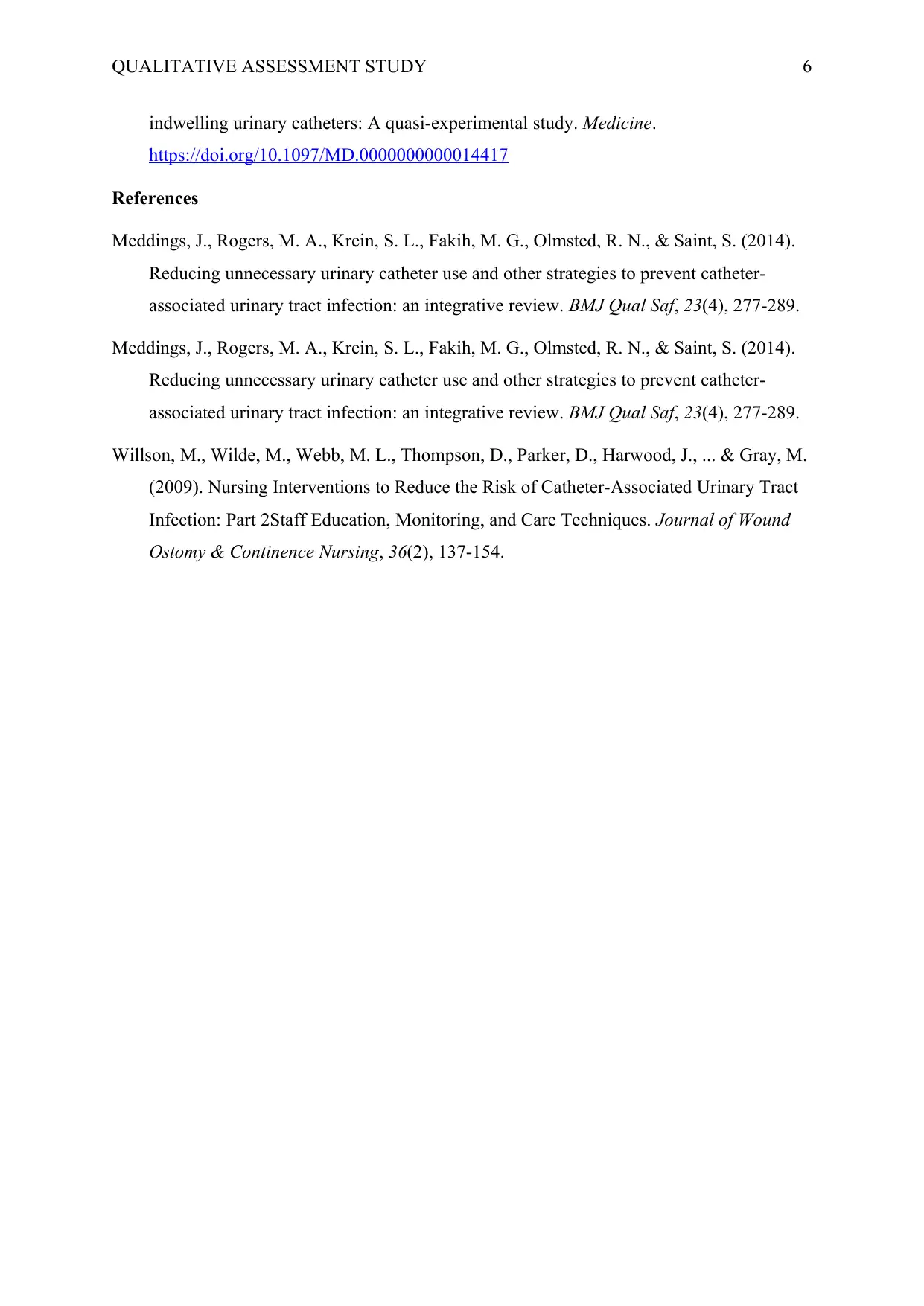
QUALITATIVE ASSESSMENT STUDY 6
indwelling urinary catheters: A quasi-experimental study. Medicine.
https://doi.org/10.1097/MD.0000000000014417
References
Meddings, J., Rogers, M. A., Krein, S. L., Fakih, M. G., Olmsted, R. N., & Saint, S. (2014).
Reducing unnecessary urinary catheter use and other strategies to prevent catheter-
associated urinary tract infection: an integrative review. BMJ Qual Saf, 23(4), 277-289.
Meddings, J., Rogers, M. A., Krein, S. L., Fakih, M. G., Olmsted, R. N., & Saint, S. (2014).
Reducing unnecessary urinary catheter use and other strategies to prevent catheter-
associated urinary tract infection: an integrative review. BMJ Qual Saf, 23(4), 277-289.
Willson, M., Wilde, M., Webb, M. L., Thompson, D., Parker, D., Harwood, J., ... & Gray, M.
(2009). Nursing Interventions to Reduce the Risk of Catheter-Associated Urinary Tract
Infection: Part 2Staff Education, Monitoring, and Care Techniques. Journal of Wound
Ostomy & Continence Nursing, 36(2), 137-154.
indwelling urinary catheters: A quasi-experimental study. Medicine.
https://doi.org/10.1097/MD.0000000000014417
References
Meddings, J., Rogers, M. A., Krein, S. L., Fakih, M. G., Olmsted, R. N., & Saint, S. (2014).
Reducing unnecessary urinary catheter use and other strategies to prevent catheter-
associated urinary tract infection: an integrative review. BMJ Qual Saf, 23(4), 277-289.
Meddings, J., Rogers, M. A., Krein, S. L., Fakih, M. G., Olmsted, R. N., & Saint, S. (2014).
Reducing unnecessary urinary catheter use and other strategies to prevent catheter-
associated urinary tract infection: an integrative review. BMJ Qual Saf, 23(4), 277-289.
Willson, M., Wilde, M., Webb, M. L., Thompson, D., Parker, D., Harwood, J., ... & Gray, M.
(2009). Nursing Interventions to Reduce the Risk of Catheter-Associated Urinary Tract
Infection: Part 2Staff Education, Monitoring, and Care Techniques. Journal of Wound
Ostomy & Continence Nursing, 36(2), 137-154.
⊘ This is a preview!⊘
Do you want full access?
Subscribe today to unlock all pages.

Trusted by 1+ million students worldwide
1 out of 6
Related Documents
Your All-in-One AI-Powered Toolkit for Academic Success.
+13062052269
info@desklib.com
Available 24*7 on WhatsApp / Email
![[object Object]](/_next/static/media/star-bottom.7253800d.svg)
Unlock your academic potential
Copyright © 2020–2025 A2Z Services. All Rights Reserved. Developed and managed by ZUCOL.




